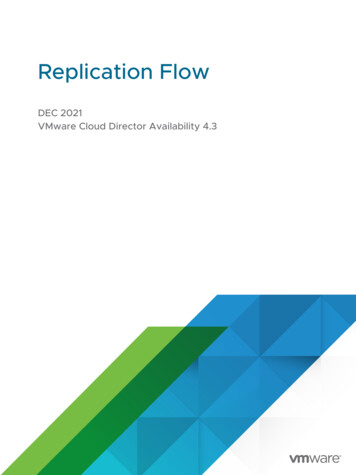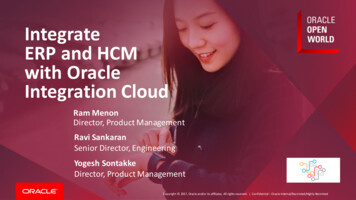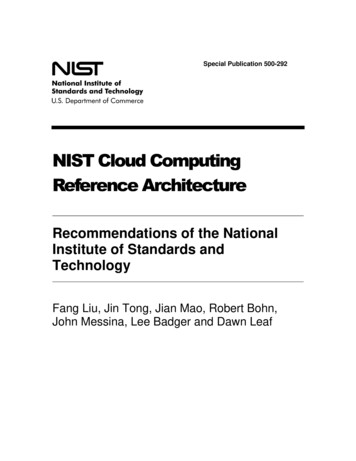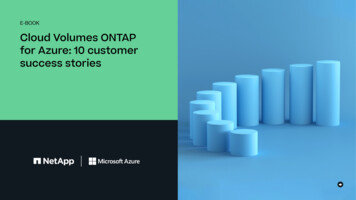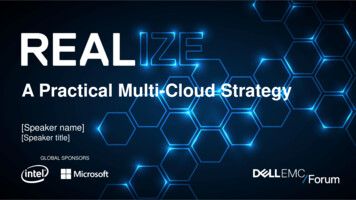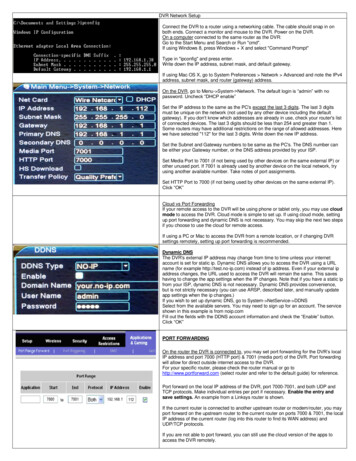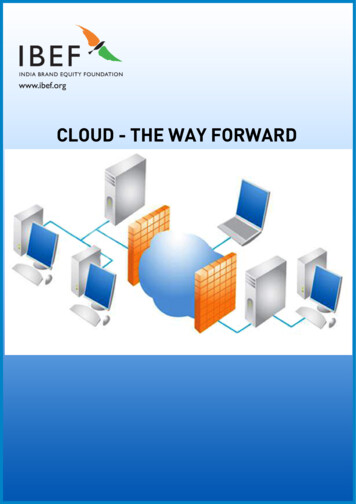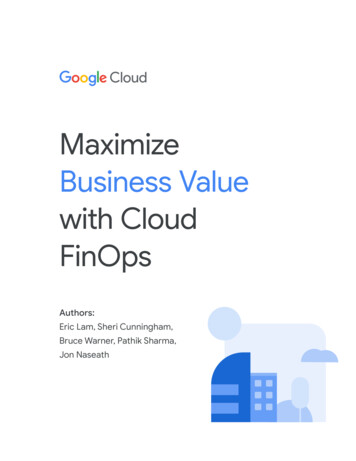
Transcription
MaximizeBusiness Valuewith CloudFinOpsAuthors:Eric Lam, Sheri Cunningham,Bruce Warner, Pathik Sharma,Jon Naseath
ContentsIntro to cloud FinOps03 Shift in IT financial managementCloud FinOps framework0407Cloud FinOps pillars1. Accountability and enablement082. Measurement and realization093. Cost optimization114. Planning and forecasting135. Tools and accelerators14Maximise business value Metrics for business value realization15Partner with Google and FinOps Foundationon cloud FinOps16Appendix A: Cost optimization matrix18Appendix B: Cloud FinOps lifecycle192
Intro to Cloud FinOpsPublic cloud adoption continues toaccelerate at a torrential pace.DefinitionPrior to the pandemic, IaaS and PaaS public cloud usagegrew 43% per year,1 and the impacts of COVID-19 haveonly served to further accelerate digital transformationand enablement of a virtual workforce.It is now forecasted that by 2030 the Fortune 500 alonemay realize over 1 trillion of EBITDA value driversassociated with public cloud enablement.2 While thefar-reaching impacts of public cloud adoption arebecoming more clear, many customers struggle toachieve near-term value objectives under their currentdeployments. Surveys estimate that 30-35% of cloudspend was wasted in 2020,3 while upwards of 80% of CIOsbelieve they had not attained the business benefits ofmigrating to the cloud. Challenges range fromestablishing effective controls on democratized resourcesinside the organization, to dynamically ensuringoptimization of new technologies, to accurately predictingconsumption-driven cost trends.In order to realize the transformational benefits of thecloud, organizations need to instill a culture oftransparency and embed agile processes. We havedistilled learnings from several organizations as theyembark on their cloud journey and valuable insightsderived from the FinOps Foundation community. Thistechnical paper aims to outline a framework for building asolid foundation for cloud financial operations (FinOps).IDC’s Whole Cloud Forecast 2019McKinsey: Cloud’s trillion-dollar prize is up for grabs, February 20213Flexera 2020 State of Cloud Report4McKinsey Study: Unlocking business acceleration in a hybrid cloud world, July 2019123An operational framework and culturalshift that brings technology, finance,and business together to drivefinancial accountability and acceleratebusiness value realization throughcloud transformation.
Shift in IT financialmanagementTraditional processes and cost controls, such as the use of capitalexpenditure (CapEx) budgets and purchase order processes to control ITspend, are often not adequately equipped to address cloud consumptionthat is largely driven by operational expenditures (OpEx).In order to achieve transformation potential, companies need to evolveprocesses, organizational skills, and tools for managing cloud investments.Management of IT finances impacts five core disciplines:1. Budget CycleFinancial planning and analysis (FP&A) teams typicallylead the annual business planning and budgeting process,in addition to quarterly forecasting and financial planning.To meet the demands and fast-moving, flexible landscapeof cloud computing, planning, and budgeting teams areadopting a more frequent feedback loop so thatoperational decisions and financial planning can align.To address constantly evolving business needs, both fromrapid growth of new applications as well as acceleratingmigrations of workloads from the data center,organizations must adopt an agile mindset that allowsthem to reassess and potentially rebalance resources at agreater frequency.4
2. Cost ownershipMany companies manage their IT budgets centrally,where costs are allocated across business units basedon revenue, headcount, and other factors. Thesebudgets are managed by IT teams who are responsiblefor cutting costs and optimizing spend. This type ofapproach can limit visibility to usage of cloud resourcesand the source of cost overruns. Establishing either‘showback’ or ‘chargeback’ processes provides theopportunity to shift cost accountability from IT tobusiness teams, who can balance resource optimizationwith business demand drivers.3. Spend controls and predictabilityTraditionally, companies have used their CapEx budgetand purchase order process to control their level of ITspend, and to drive their financial forecast process usingtheir depreciation schedule of prior CapEx purchasesalong with trend-based estimates of OpEx spend.These processes limit ability to effectively control largelyOpEx-driven cloud spend, while forecasting using trendbased methods can result in variances of 25% or more.Companies that have successfully adopted cloudfinancial controls can utilize automated budgeting andspend control tools to enable engineering teams todynamically provision cloud resources, while creatingreal-time notifications on spending thresholds.Furthermore, the use of driver-based forecasting modelshave enabled a high degree of spend predictability.5
4. Financial governanceThe adoption of cloud has created a shift fromtraditional data center CapEx to a new financial modelthat may involve both approaches to capitalization aswell as OpEX treatment. Many customers are activelyinvestigating accounting treatment for new cloudstructures and offerings, potentially highlightingoutdated financial guidelines.The lack of clear cloud accounting guidelines may causedelays in adoption of cloud capabilities and harnessingthe benefits of the shift. Staying ahead of cloudadvancements calls for clear guidelines and financialpolicies to identify and allocate cloud spend areas.5. PartnershipWe are beyond a time when IT could operate with minimalcross-functional partnerships and collaboration. It is notpurely a necessary cost to the business—rather, it is anaccelerator in capturing value for the organization. Strongpartnerships across IT and business teams are a vitalcomponent to realizing cloud value.6
Cloud FinOps frameworkIncluding a FinOps strategy is an essential element for any enterprisemaking significant investments in PaaS or IaaS capabilities.The ability to link a cloud migration business case with value metrics to a detailed costvisibility dashboard with automated expense controls is essential to the mission control ofyour company’s next IT ‘moonshot’. Below is a framework for achieving five core aspects ofthe cloud transformation journey, in pursuit of realizing the business value of cloud.Guiding principlesRegardless of the organization size and their experience in cloud, we have seen these guidingprinciples deeply rooted for successful execution of cloud FinOps:Cost transparencyBlamelessnessAccess to real-time billing/cost data at all layers in theorganization.Treat mistakes as blameless opportunities to learnand improve existing processes.CollaborationAccountabilityPartner with IT Finance, Application Development, andInfrastructure teams for cloud financial management.Hold application teams responsible for valuerealization reporting and cost optimization with a setof clearly defined KPIs and metrics.Variable nature of cloudAgilityEmbrace the pay-as-you-go nature of cloud and benefitby serving your customers dynamically during theirconstantly changing needs.Drive agile processes for budgeting and planningwithin IT by promoting iterative budget allocation, ITspending, and forecasting.Business Value RealizationFinOps is successful when decisions are made from abusiness value perspective.7
Cloud FinOps pillar1Accountability and enablementA core ingredient to building a culture of cost and valueawareness, accountability, and enablement charts thecourse for both the process and cultural transformationjourney in cloud FinOps.The primary goal here is to help drive financial accountability and acceleratebusiness value realization by streamlining IT financial processes and enablingfrictionless cloud governance. Enablement empowers IT, finance, and businessteams with training to better understand cloud resources and strategies toefficiently deploy and manage them. Driving accountability and enablementstarts with a charter and core governance policies, and then guides thetransformation of processes that link finance, IT, and business owners.TacticalStrategicTransformationalInitial charter forcreating accountabilityand enablementestablished.Cloud governance andpolicies are understoodwithin the organization.Strong partnershipwith Finance andBusiness teams toperiodically reviewand optimize spend.8
Cloud FinOps pillar2Measurement and realizationFoundational to any good process is accurate dataand effective metrics, which start with the labelingand tagging data architecture behind your company’suse of cloud resources.While many common tags include IT-driven designators such as application,environment, and project, it is important to design a direct connection to your P&Linto your labeling and tagging architecture, by including cost centers or the chartof accounts as tags. Automation of tagging will ensure that all taggableresources are deployed with accurate labels. This data will subsequently enableKPIs that both monitor the efficiency of cloud resources as well as measureorganizational value objectives.9
Like many aspects of cloud FinOps,metrics and KPIs are commonly a journey.Customers typically start this journey with resource optimization metrics such asactual vs. budget per service, % underutilization of services (including agedsnapshots, idle instances, and over-sized resources), right-sizing opportunityvalue, and spend per application. Pricing optimization metrics typically start withCommited Use Discount and Preemptible Instance coverage ratios and idleon-demand resource ratios, while compliance metrics focus on label, security,cost, and usage compliance.Once these foundational metrics are established, development of more advancedKPIs can include operational and security stability (incidence or downtime rates),devops release frequency, return on innovation, and unit metrics (cost percustomer served). Unit metrics can be a very powerful tool to connect acrossbusiness functions, providing at the same time an operational metric on costconsistency, a target for architecting future cost structure, and a connection tosales and marketing demand drivers. Developing effective unit metrics requiresclose coordination between finance, IT, and business owners to identify the Bookof Record, reporting cycle and cutoffs, and designing for auditability.Effective measures not only create awareness and enable agile processes, butalso support a culture that celebrates success and rewards teams for achievingnew ished set ofassets level KPIs forcost optimization.KPIs are mapped tobusiness servicesand outcomes.Cost optimizationculture embeddedinto the organization.10
Cloud FinOps pillar3Cost optimizationCloud cost optimization is not just about cuttingcosts—it's about knowing where to spend yourmoney to maximize the business value.It is an iterative and continuous process that provides a consistent methodologyto visualize and manage cloud consumption in a most cost effective manner.Success in cost optimization can result not only in significant reductions of cloudspend, but also in re-architecting for improved application performance tomanage user demand growth within the same cost envelope.Equation for cloud costCloud cost Resources rmationalLimited use ofresource and rateoptimization acrossvarious teams.Access to timelyand accurate costreports. Accountabilityfor resource and rateoptimization.Business valuetracking aligned andcost optimizationembedded at all layers.11
Cost optimization strategies address three factors:Cost visibilityResource optimizationRate optimizationIdentify what you spend, howservices are billed, and moreimportantly the ability toshowcase why you spent aspecific amount to achieve abusiness outcome. This isfoundational to fullyunderstanding and organizingcloud costs. This is wherebusiness, IT, and Finance cometogether to define taggingpolicies and accurately map thecosts back to business units forvalue tracking.Focus on eliminating cloud waste(idle resources), autoscale wherenecessary, and rightsize thecompute and storage tier to onlyuse what you need. Often thisfunction is decentralized, sinceengineering has the most contexton where and how to optimize theresource used.Leverage deeper discounts usingreservations such as committedusage, preemptible VMs, flat ratepricing, as well as volume andcontract discounting where youpay lower rates for the sameresources. To maximize costoptimization, often thesedecisions are made centrally byFinOps or CoE teams.We have seen many successful examples like Optiva, MD Insider, and Raycatch wherecustomers optimize their total cost of ownership by leveraging Google-managed services aswell as serverless offerings to offload operational overhead, thus allowing them to focus ongrowing their business. See Appendix A for a cost optimization matrix.To learn more about the cost optimization strategy in detail, check out the free technicalpaper, “Understanding the principles of cost optimization,” explore our solutions guide, or seehow OpenX reduced their per-unit cost by more than 60% on Google Cloud. For a holistic viewon deploying applications with operational excellence, security, reliability, and performancealong with cost check out Architecture Framework.12
Cloud FinOps pillar4Planning and forecastingPreparing for a data center technology refreshtypically takes six to nine months or longer oninfrastructure that will be used for five years or more.It requires customers to assess long-term workload demands and acquireinfrastructure with significant advanced notice. The average data center utilizesless than half of its compute capacity over its lifecycle due to physical hardwareimmutability. By comparison, customers can establish ‘hand-in-glove’ sizing ofcloud resources, eliminating wasteful overhead, and leverage auto-scalingtechnology to burst when demand does. This allows for much less waste andbetter business results.Establishing accurate financial forecasting requires rethinking traditionalapproaches to depreciation run-outs and trend-based forecasting of maintenanceand licensing costs. Using workload-specific forecasting models that leverage acombination of trend-based models for steady-state workloads, driver-basedmodels for scaling applications, as well as monthly variance analysis can greatlyimprove the accuracy of dynamic cloud needs.TacticalStrategicTransformationalManual invoicereconciliation andcost allocation.Partial visibilityinto accounting ofcloud spend.Budget planning andforecasting closely alignedwith variable consumptionmodel in the cloud.13
Cloud FinOps pillar5Tools and acceleratorsEmploying proper tools and accelerators areimportant to fully benefiting from FinOps practices.In earlier stages, companies may have limited their ability to report detailedanalysis of cloud spend. As practices mature and improve, labeling andtagging of resources proves valuable to understanding costs for specificprojects and teams. These capabilities become even more powerful throughautomated monitoring of resources through a dashboard that offers insightson spend and value.TacticalStrategicTransformationalLimited capabilityto report on accurateaccounting ofcloud spend.Basic cloud resourcetagging/labelingare available.Automated tools andreporting dashboardto manage cloudspend and value.14
Maximize business valueCapturing business value with cloud requires a shift in mindset of continuouslyoptimizing overall cloud spend and ensuring that resource usage aligns toinvestments that are revenue-driving, innovative, or cost-cutting.Metrics for business value realizationBusiness value realization falls across several factors:cost efficiency, velocity, and innovation. We suggestassigning KPIs to the following metric categories:Cost efficiencyResiliencyVelocityInnovationMeasure costefficiency throughinfrastructure savings,migration, and supportcosts.Enhance operationalresiliency withimprovement inservice quality andsecurity risk posture.Increase time tomarket by acceleratingfluidity in product andservice delivery.Enable a culture ofrapid experimentationto drive innovation andcloud transformation.InfrastructureService qualityDeveloper productivityReturn on innovationSupportSecurity postureRelease frequencyEmployee experienceImplementationOperational stabilityBusiness agilityCustomer satisfaction15
Partner with Google and FinOpsFoundation on cloud FinOpsSo, where are you now in your FinOpsjourney, and how do you move beyond thechallenges ahead? Google can help you startthe conversation and accelerate your path tomaximizing business value with the cloud.No matter where you are on the cloud transformationjourney, through an interactive session with Google, webring executives across the organization together to worktoward a shared vision and a plan to accelerate andrealize business value in the cloud. If you are interested inmore information, please contact us and / or join thevibrant community of Finops Foundation.OpenXLearn how OpenX reduced theirper unit cost by more than 60%on Google Cloud.Get in touchIf you are interested in more information, please go tocloud.google.com/contact16
Appendix A:Cost optimization matrixCost Optimization MatrixHigh effort //low savingsHigh effort //high savingsHighRe-architecting: Serverless,Containerization, etc.Re-platforming:Managed ServicesRightsizingStorage LifecycleManagementPreemptible VMsAutoscalingBigQuery SlotsIdle resourcesLowLow effort //low savingsCustomMachine TypeCommited UseDiscountsLow effort //high savingsHigh effort // high savingsLow17High
Appendix B:Cloud FinOps lifecycleCloud FinOps epics organized across the FinOps lifecycleTo help guide our customers bringing the cloud FinOps capabilities and building blocks into action, Googlehas also aligned the cloud FinOps epics across the FinOps lifecycle (as proposed in FinOps Foundation).1. Inform1Report KPIs & costAllocateOnboard workloadsInformInformMake information visibleForecastMake information ate & enable3. OperateOptimizeDrive Cloud efficientlyDrive Cloud efficientlyIncentivizePricingefficiency2. OptimizeMeasure valueFunding3OperateOperateEmbed FinOps & drive self-sufficientlyGuardiansEmbed FinOps & drive self-sufficiently18
Bruce Warner, Pathik Sharma, Jon Naseath. Contents Intro to cloud FinOps Shift in IT financial management Cloud FinOps framework Cloud FinOps pillars 1. Accountability and enablement 2. Measurement and realization 3. 11Cost optimization 4. Planning and forecasting 5. Tools and accelerators Maximise business value Metrics for business value realization Partner with Google and FinOps .


